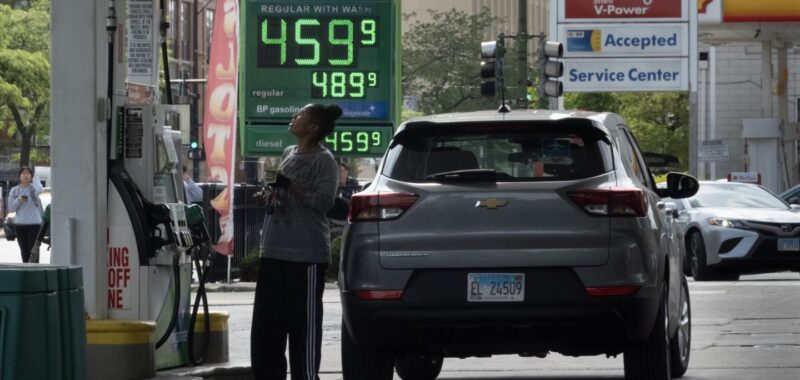Gas prices could be about to get cheaper, just in time for summer road travel, as about 42 million gallons of gasoline makes its way into the fuel market.
In May, the Biden administration announced that the one million barrels of gasoline in the Northeast Gasoline Supply Reserve were up for sale. Contracts were awarded to five companies, and barrels were sold at an average of $2.34 per gallon. The gasoline was released to the contracted companies as of June 30.
Amos Hochstein, deputy assistant to the president and senior advisor for energy and investment, says the release of gas should soon help drive down costs at the pump or, at least, prevent the price from increasing.
“It’s not even oil — it’s a million barrels of gasoline directly into the gas market,” says Hochstein, who is the leading expert and advisor to President Joe Biden on gasoline. By contrast, when oil reserves are released it still takes time to refine into gasoline. This action will move gas into the U.S. supply faster, but it’s one that can’t be done very often, says Hochstein.
“This is a one shot deal,” says Hochstein, adding that it was timed before July Fourth to blunt the pressure on gas supply due to travel demands.
For context, 42 million gallons is about 11% of the total amount of gas that vehicles guzzle each day in the U.S., about 376 million gallons.
Lowering gas prices doesn’t just benefit the average driver, it also means trucks that deliver supplies and food can run on cheaper fuel. Gas costs are factored into overall prices of goods, so cheaper gas can, theoretically, bring down prices — or at least prevent them from going up.
Cheaper gas prices certainly can’t hurt Biden, whose campaign is still reeling from last week’s debate in which the president’s performance was so poor it prompted a bevy of outlets to call for him to bow out of his bid for reelection. Presidents don’t control gas prices, but they can enact policies related to drilling, refining and, in the case of today’s news, releasing gas from reserves. Those actions can ultimately impact what drivers pay at the pump.
Who will see cheaper gas?
Gas prices have come down since hitting a peak in June 2022 when the average price for regular unleaded gas was $5.016, according to AAA, which tracks gas prices. As of today, the national average gas price is $3.501, according to AAA. It’s up negligibly from last week’s average of $3.469 and slightly lower than the average of $3.535 at the same time one year ago.
This release of gas should flow supply into gas stations during the Fourth of July rush. It’ll primarily impact Northeast states including Maine, New Hampshire, Vermont, Massachusetts, Connecticut, Rhode Island, New York, New Jersey, and Pennsylvania. But Hochstein says it could reach the Midwest, as well.
The Northeast will see cheaper gas because the barrels originate in the Northeast Reserve. “When we sell this gasoline into the market, it loses value if you’re trucking it across the country,” says Hochstein. “It is most valuable in the immediate area where it is in the Northeast.”
Average gas prices tend to be highest out West with California ($4.790) leading the pack, followed by Hawaii ($4.702), Washington ($4.306), Oregon ($4.051) and Nevada ($4.035). On the low end, typical prices are found in Southern states led by Mississippi ($2.957), Louisiana ($3.028), Arkansas ($3.060), Oklahoma ($3.080) and Texas ($3.099).
What influences gas prices?
Gas prices are set based on several factors including the price of raw crude oil — more than half the price — and the cost of refining that oil. The price of benchmark West Texas Intermediate crude is a bench market for oil prices in North America. Since its peak of $115 in the summer of 2022, West Texas Intermediate crude has fallen to around $83 today.
Today’s oil prices are influenced by global factors including the war between Russia and Ukraine and the war in the Middle East. Both areas producing oil and gas are under a lot of strain, says Hochstein. In 2022, following the start of the war between Russia and Ukraine, the administration announced a 180 million-barrel sale of crude oil from the Strategic Petroleum Reserve to increase gas supplies.
Beyond oil and refining costs, gas prices also include a federal tax of 18.4 cents per gallon and a state tax. On Monday, seven states hiked gas taxes.
Timing of the release of this gas was critical, says Hochstein. That’s because gas prices tend to go up during the summer largely due to several factors:
-
Higher demand due to summer travel. AAA estimates that nearly 71 million people are expected to travel over the entire July 4 week, with 60.6 million traveling by car — a record high.
-
The switch to summer-blend gasoline, which costs more than winter-blend gasoline.
-
Vehicles are less efficient during the summer months due to heat.
-
Hot temperatures that can make it difficult to refine oil, as well, which can take its toll on gas supplies.
-
Hurricanes and other extreme weather events in areas where oil drilling and refining take place.
(Photo by Scott Olson/Getty Images News via Getty Images)

